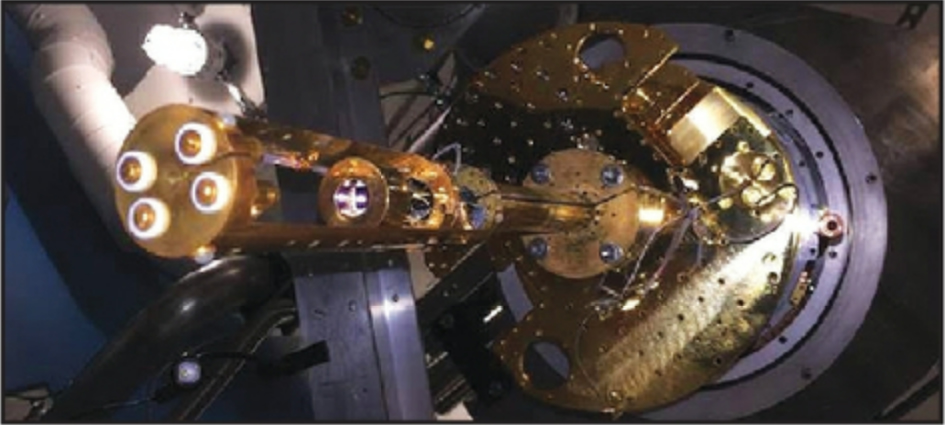
U.S. Tech – April 2022
Special Features: Manufacturing Services
Isolating Vibration to Better Understand Quantum Electronics
By Jim McMahon
Researching the physics of two-dimensional layered crystalline materials, like graphene, zirconium, germanene, silicone, and borophene, is of considerable interest in universities because of the potential benefits for industry.
A crystalline allotrope of carbon, graphene, for example, is hundreds of times stronger than steel by weight, with the highest known thermal and electrical conductivity, displaying current densities one million times that of copper. Better understanding the character and properties of graphene, and similar two-dimensional materials, will advance their integration into improvements for semiconductors, electronics, photo-voltaics, battery energy storage and many other applications.
Single-Atom Layers
One university laboratory that has been conducting research with graphene and other atomically-thin materials for some years is the Henriksen Research Group at Washington University in St, Louis, Missouri.
 Vibration isolation system supporting single-atom layer materials research
Vibration isolation system supporting single-atom layer materials research
The Group is an experimental lab dealing with dense matter physics, essentially, any material in condensed form — matter, liquids and gases — but with a focus on two-dimensional crystalline materials (sometimes called low-dimensional), consisting of a single layer of atoms.
"Our experiments entail the careful measurement of the electronic properties of thinly-layered materials, including both electronic transport and thermo-dynamic quantities, such as the magnetization and compressibility of electron gas," says Dr, Erik Henriksen, leading professor of the Henriksen Research Group, "We also conduct measurements of the infrared absorption spectrum to probe the electronic structure directly.”
The group searches for unusual and unexpected properties of low-dimensional materials, utilizing a combination of electronic, optical and thermodynamic measurement approaches to understand the novel quantum electronic phases that arise. The experiments are generally conducted at very low temperatures, fractions of a degree Kelvin above absolute zero, and in high magnetic fields, employing custom devices made of graphene or related crystals.
"Our present work focuses on the potential to realize topological electronic phases in graphene, centered on the properties of electrons confined to two dimensions, and on the infrared spectrum of graphenes quasi-relativistic electrons,” adds Henriksen, "Both lines of research require precise control of the presence and character of disordering impurities near the graphene sheet.”
"We look at the physics of the layered graphene, where the layers are weakly bound, so they can be pulled apart” explained Henriksen. "We isolate these very thin layers down to a single atom. Then, lift the graphene flakes from bulk graphite with adhesive tape, transferring them very carefully onto silicon wafers."
Once on the silicon wafers, the exfoliated graphene flakes are encapsulated for protection, and transported to a cleanroom with a cryostat ultra-high vacuum chamber for AFM measurements, infrared spectrum absorption and related testing-Preparing Samples.
The preparation of the graphene samples is performed on an AFM positioned in an inert glovebox. The graphene samples selected are 10 to 30 microns wide and one atom thick-Manipulating these samples and positioning them on wafers, consequently, requires a stable platform for the atomic force micro scope. For this purpose, the lab selected a Negative-Stiffness vibration isolation system.
Negative-Stiffness vibration isolation was developed by Minus K Technology, an OEM supplier to leading manufacturers of scanning probe microscopes, micro-hardness testers and other vibration-sensitive instruments and equipment, such as for testing zero-g simulation of spacecraft. The company's isolators are used by more than 300 universities and gov eminent laboratories in 50 countries,
These vibration isolators are compact, and do not require electricity or compressed air which enables sensitive instruments to be located wherever a production facility or laboratory needs to be located. There are no motors, pumps or chambers, and no maintenance because there is nothing to wear out. They operate purely in a passive mechanical mode,
What is very advantageous about Negative-Stiffness isolators is that they achieve a high level of isolation in multiple directions. These isolators have the flexibility of custom tailoring resonant frequencies, "Vertical-motion isolation is provided by a stiff spring that supports a weight load, combined with a Negative-Stiffness mechanism," says Dr, David Platus, founder and president of Minus K Technology, a company that now builds his invention: the Negative-Stiffness vibration isolator." The net vertical stiffness is made very low without affecting the static load-supporting capability of the spring.
Beam-columns connected in series with the vertical-motion isolator provide horizontal-motion isolation. A beam-column behaves as a spring combined with a negative-stiffness mechanism. The result is a compact passive isolator capable of very low vertical and horizontal natural frequencies and high internal structural frequencies"
Measurements of atomic precision, like that required for graphene exfoliation, require isolation from ambient vibrations coming from internal and external sources.
Although the Henriksen Research Groups research laboratory is situated in the basement of a building on the university campus, it is still influenced by vibrations from the buildings mechanical systems, as well as doors opening and closing, and footfall.
"The Minus K Negative-Stiffness isolator is awesome,' says Henriksen, "It not only provides superb isolation performance for our NanoMagnetics AFM, but it also fits nicely into the glovebox, We have two Negative-Stiffness isolators now, they are very cool systems."
Contact: Minus K Technology, Inc., 460 Hindry Avenue, Unit C, Inglewood, CA 90301, 310-348-9656 E-mail: request@minusk.com Web: www.minusk.com
|